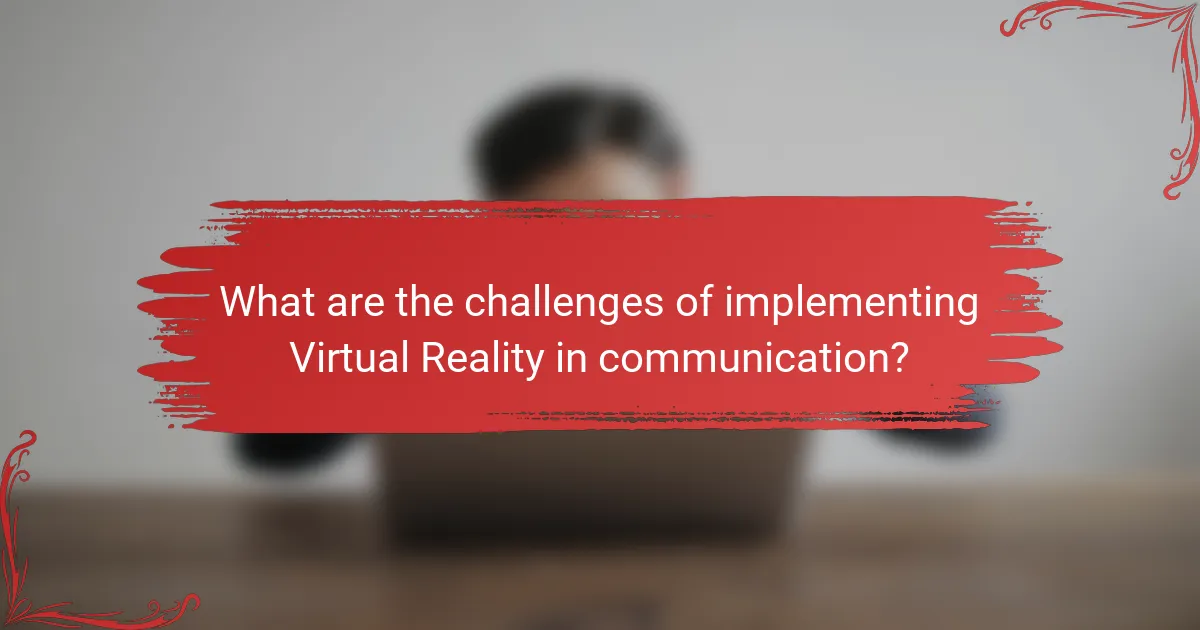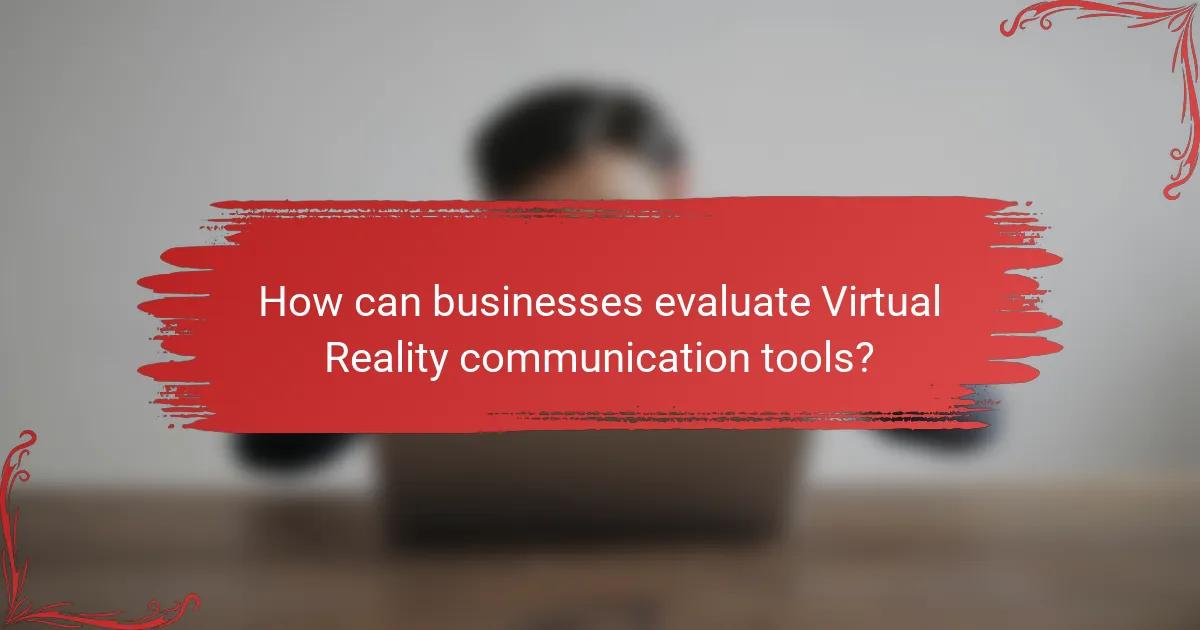Virtual Reality (VR) is revolutionizing communication by offering immersive experiences that foster deeper interaction and collaboration. As urban populations expand and remote work becomes prevalent, VR emerges as a powerful tool to bridge distances, enhancing engagement and understanding across various sectors such as education, healthcare, and corporate environments.

How is Virtual Reality transforming communication in major cities?
Virtual Reality (VR) is significantly changing communication in major cities by enabling immersive experiences that enhance interaction and collaboration. As urban populations grow and remote work becomes more common, VR provides innovative solutions for effective communication across distances.
Enhanced remote collaboration
VR facilitates remote collaboration by creating virtual workspaces where teams can meet and interact as if they were in the same room. This technology allows participants to share documents, brainstorm ideas, and visualize projects in a 3D environment, making discussions more engaging and productive.
For example, companies can use VR platforms to conduct meetings that simulate face-to-face interactions, reducing the feeling of isolation often experienced in remote work. Tools like virtual whiteboards and 3D models can enhance understanding and foster creativity among team members.
Immersive social interactions
VR transforms social interactions by providing immersive environments where users can connect in a more meaningful way. Virtual social spaces allow people to meet, play games, or attend events together, regardless of their physical location.
In cities, this can lead to new forms of community engagement, such as virtual art exhibitions or concerts, where participants can interact with each other and the content in real-time. These experiences can help bridge cultural gaps and foster a sense of belonging among diverse groups.
Real-time language translation
VR technology is integrating real-time language translation features, making communication across language barriers seamless. This capability allows users to engage in conversations without needing to speak the same language, enhancing collaboration in multicultural environments.
For instance, during a virtual meeting, participants can hear translations of spoken words in their preferred language, enabling smoother interactions and reducing misunderstandings. This feature is particularly valuable in global cities where diverse populations interact frequently.

What are the key benefits of using Virtual Reality for communication?
Virtual Reality (VR) enhances communication by creating immersive environments that facilitate interaction and understanding. Key benefits include increased engagement, improved comprehension of complex ideas, and a stronger emotional connection among participants.
Increased engagement
VR captures attention more effectively than traditional communication methods. Users are immersed in a 3D environment, which can lead to higher retention rates and active participation during discussions or presentations.
For example, virtual meetings can simulate real-world settings, making participants feel as if they are physically present together. This level of engagement can significantly enhance collaboration and creativity in team projects.
Improved understanding of complex concepts
Virtual Reality allows users to visualize and interact with complex ideas in ways that are difficult to achieve through text or images alone. By manipulating 3D models or simulations, users can gain a clearer understanding of intricate subjects.
For instance, in fields like medicine or engineering, VR can provide hands-on experiences that illustrate processes or systems, making learning more intuitive and effective. This method can reduce the time needed to grasp challenging concepts.
Greater emotional connection
VR fosters a sense of presence that can enhance emotional connections between individuals. By sharing experiences in a virtual space, users can build rapport and empathy more easily than through standard video calls.
In scenarios like remote team-building activities or therapy sessions, the immersive nature of VR can help participants feel more connected, leading to improved relationships and communication dynamics. This emotional engagement can be crucial for effective teamwork and collaboration.

What industries are adopting Virtual Reality for communication?
Virtual Reality (VR) is increasingly being adopted across various industries for communication, enhancing engagement and interaction. Key sectors include education, healthcare, and corporate environments, where VR facilitates immersive experiences that traditional methods cannot match.
Education and training
In education, VR is transforming how students learn by providing immersive environments that enhance understanding and retention. For instance, virtual classrooms allow students to explore historical sites or conduct science experiments in a safe, controlled setting.
Training programs in fields like aviation and manufacturing utilize VR simulations to prepare individuals for real-world scenarios. This method not only reduces costs associated with physical training but also allows for repeated practice without the risks involved in live training.
Healthcare and therapy
Healthcare professionals are using VR for various applications, including surgical training and patient therapy. Surgeons can practice complex procedures in a virtual environment, improving their skills before operating on real patients.
In therapy, VR is effective for treating conditions such as PTSD and phobias by exposing patients to controlled simulations of their fears. This exposure therapy can lead to significant improvements in mental health outcomes.
Corporate and business meetings
Corporations are leveraging VR for remote meetings, allowing teams to collaborate in a virtual space that mimics a physical office. This technology fosters a sense of presence and connection among team members, which can be lacking in traditional video calls.
Additionally, VR can enhance presentations and product demonstrations, providing a more engaging experience for clients and stakeholders. Companies should consider investing in VR tools to improve communication efficiency and team collaboration.

What technologies enable Virtual Reality communication?
Virtual Reality communication relies on a combination of advanced technologies that create immersive environments for users to interact. Key components include VR headsets, collaboration platforms, and 3D modeling software, each playing a crucial role in enhancing virtual interactions.
VR headsets like Oculus Quest
VR headsets, such as the Oculus Quest, are essential for experiencing virtual environments. These devices provide high-resolution displays and motion tracking, allowing users to engage in realistic interactions. The standalone nature of the Oculus Quest makes it accessible, as it does not require a powerful PC, enabling a wider audience to participate in VR communication.
When choosing a VR headset, consider factors like comfort, battery life, and available content. The Oculus Quest offers a range of applications for social interaction, gaming, and professional collaboration, making it a versatile choice for various users.
Collaboration platforms like Spatial
Collaboration platforms like Spatial facilitate virtual meetings and teamwork in immersive settings. These platforms allow users to create avatars and interact in 3D spaces, enhancing the sense of presence compared to traditional video calls. Spatial supports various devices, including VR headsets and desktop computers, making it inclusive for all participants.
To maximize the effectiveness of these platforms, ensure a stable internet connection and familiarize yourself with the tools available for collaboration, such as virtual whiteboards and file sharing. This preparation can significantly improve the overall experience during virtual meetings.
3D modeling software like Blender
3D modeling software, such as Blender, plays a vital role in creating the virtual environments used in VR communication. Blender allows users to design detailed 3D models and animations, which can be integrated into VR platforms for enhanced interaction. Its open-source nature makes it accessible to a broad audience, from hobbyists to professionals.
When using 3D modeling software, focus on optimizing models for performance in VR. Keep polygon counts manageable and use efficient textures to ensure smooth experiences. Learning basic modeling techniques can significantly enhance the quality of virtual environments, making them more engaging for users.

What are the challenges of implementing Virtual Reality in communication?
Implementing Virtual Reality (VR) in communication faces several challenges, including high costs, the necessity for user training, and the risk of motion sickness. These factors can significantly impact the adoption and effectiveness of VR technologies in various communication settings.
High cost of technology
The high cost of VR technology is a significant barrier to widespread adoption. Quality VR headsets and supporting hardware can range from hundreds to thousands of dollars, making it a substantial investment for businesses and individuals alike. Additionally, ongoing costs for software updates and maintenance can further strain budgets.
Organizations must weigh the benefits of VR communication against these costs. For instance, while VR can enhance remote collaboration, the initial investment may not be justifiable for smaller companies or those with limited budgets. Exploring options like leasing equipment or utilizing lower-cost alternatives can help mitigate these expenses.
Need for user training
Effective use of VR in communication requires users to undergo training, which can be time-consuming and resource-intensive. Familiarizing users with VR interfaces and functionalities is essential for maximizing the technology’s potential. Without proper training, users may struggle to navigate VR environments, leading to frustration and decreased productivity.
To address this challenge, organizations should develop comprehensive training programs that include hands-on practice and ongoing support. Providing easy-to-follow tutorials and resources can help users become proficient more quickly, ensuring a smoother transition to VR communication tools.
Potential for motion sickness
Motion sickness is a common concern when using VR technology, as some users may experience discomfort due to the immersive nature of the experience. Symptoms can include dizziness, nausea, and headaches, which can hinder effective communication and limit the time users can spend in VR environments.
To minimize the risk of motion sickness, developers can design VR experiences with user comfort in mind. Implementing features such as adjustable settings for movement speed, offering breaks, and providing clear exit options can help users manage their experiences better. Educating users about these potential issues can also prepare them for a more comfortable VR communication experience.

How can businesses evaluate Virtual Reality communication tools?
Businesses can evaluate Virtual Reality (VR) communication tools by assessing user experience, comparing pricing models, and evaluating integration capabilities. These factors help determine which tools best meet their communication needs and budget constraints.
Assess user experience
User experience (UX) is crucial when evaluating VR communication tools. A tool should provide an intuitive interface, seamless navigation, and engaging interactions to ensure users can communicate effectively without technical distractions.
Consider conducting user testing with a sample group to gather feedback on usability and engagement. Look for tools that offer immersive environments and realistic avatars, as these features can significantly enhance communication quality.
Compare pricing models
Pricing models for VR communication tools can vary widely, often including subscription fees, one-time purchases, or tiered pricing based on features. Businesses should compare these models to find the most cost-effective solution that aligns with their budget and usage frequency.
For example, some tools might charge monthly fees ranging from $10 to $50 per user, while others may offer enterprise solutions that can cost thousands of dollars annually. It’s essential to weigh the costs against the features provided to ensure value for money.
Evaluate integration capabilities
Integration capabilities are vital for ensuring that VR communication tools work seamlessly with existing systems and software. Businesses should assess whether the tools can integrate with platforms like CRM systems, project management tools, or collaboration software.
Look for tools that offer APIs or built-in integrations to facilitate smooth data exchange. This can enhance productivity and reduce the need for additional training, making the transition to VR communication more efficient.
